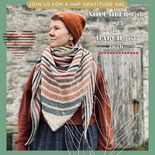patterns > The Shetland Trader >  The Shetland Trader, Book Three: Heritage
The Shetland Trader, Book Three: Heritage
> Tarra









Tarra
Order your copy here! Gudrun Johnston joins forces with Pom Pom Press for the latest instalment of her Shetland Trader series. This third volume explores the very roots of the series: the made-to-order knitwear business run in the 1970s by Patricia Johnston, Gudrun’s mother, which operated as The Shetland Trader. Through archival research and a network of family, friends, and fibre enthusiasts, Gudrun has unearthed some of her mother’s best-loved designs and updated them for contemporary knitters. This collection contains 11 patterns for garments and accessories. Use them to create seventies-inspired dream ensembles as well as heirloom pieces incorporating traditional Shetland knitting techniques and motifs
Tarra
This is the smaller, more scarf-like interpretation of Vatna (also from my Shetland Trader Book Three). It uses the same Razor Shell patterning but has a shallower body that is shaped with the use of short rows.
One Size:
Wingspan: Approx 140.5cm / 55 ¼“ Depth: 30cm / 11¾”
Yarn (fingering / 4-ply-weight yarn in the following amounts):
Jamieson’s of Shetland Spindrift (fingering / 4-ply-weight; 100% Shetland Wool; 105m / 115yds per 25g ball)
MC: Shaela; 2 balls
CC1: Auld Gold; 1 ball
CC2: Camel; 1 ball
CC3: Cocoa; 1 ball
OR approx
MC: 145m / 155yds
CC1: 120m / 130yds
CC2: 105m / 110yds
CC3: 35m / 35yds
Gauge:
18 sts & 26 rows = 10cm / 4” over Razor Shell Pattern on 4.5mm needles after blocking
17 sts & 24 rows = 10cm / 4” over Garter Stitch on 4.5mm needles after blocking
Needles:
4.5mm / US 7 circular needle, 100cm / 40” length
5.5mm / US 9 circular needle, 100cm / 40” length (for the cast on)
Always use a needle size that will result in the correct gauge after blocking.
Notions:
Tapestry needle for weaving in ends
Notes:
The shawl is worked from the outside in, starting with the widest edge. The body of the shawl is worked with a combination of short rows and some decreasing, creating a shallow shape and resulting in a long cast-off section at the end.

32116 projects
stashed
56642 times
- First published: October 2021
- Page created: September 23, 2021
- Last updated: March 24, 2023 …
- visits in the last 24 hours
- visitors right now





